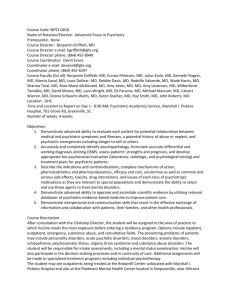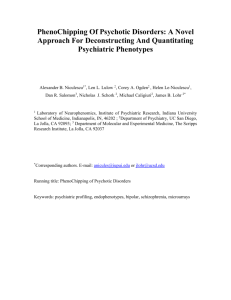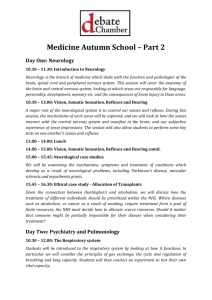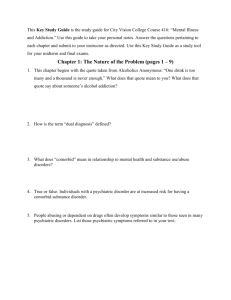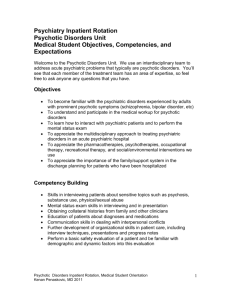General Medical Officer (GMO) Manual: Psychiatry Emergencies
advertisement
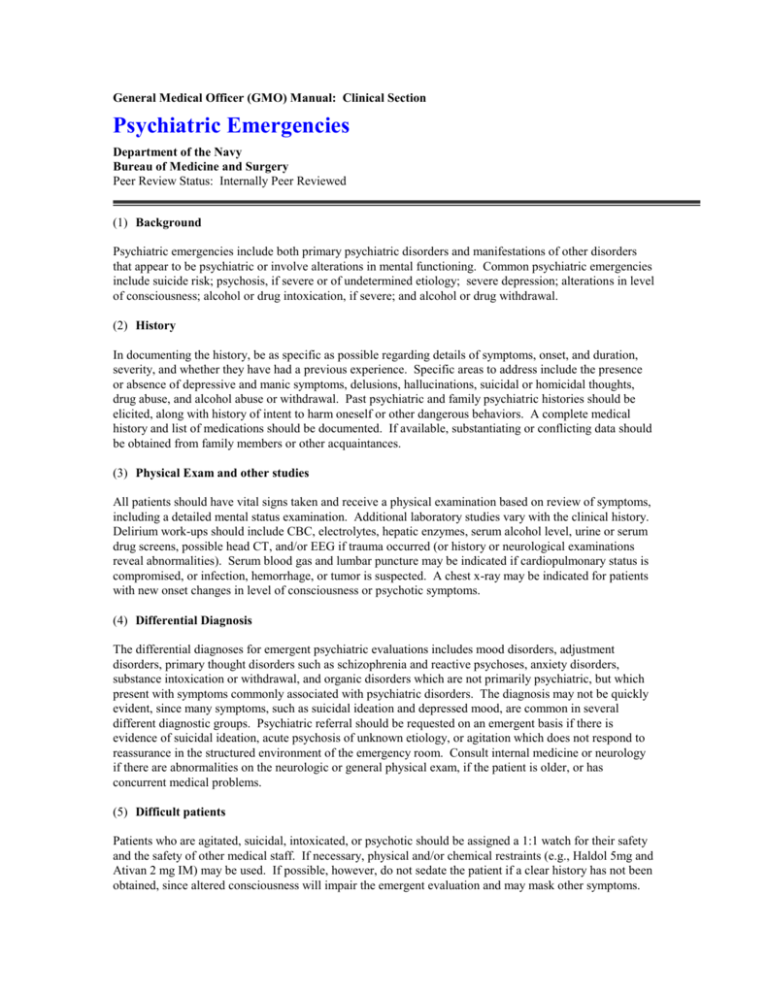
General Medical Officer (GMO) Manual: Clinical Section Psychiatric Emergencies Department of the Navy Bureau of Medicine and Surgery Peer Review Status: Internally Peer Reviewed (1) Background Psychiatric emergencies include both primary psychiatric disorders and manifestations of other disorders that appear to be psychiatric or involve alterations in mental functioning. Common psychiatric emergencies include suicide risk; psychosis, if severe or of undetermined etiology; severe depression; alterations in level of consciousness; alcohol or drug intoxication, if severe; and alcohol or drug withdrawal. (2) History In documenting the history, be as specific as possible regarding details of symptoms, onset, and duration, severity, and whether they have had a previous experience. Specific areas to address include the presence or absence of depressive and manic symptoms, delusions, hallucinations, suicidal or homicidal thoughts, drug abuse, and alcohol abuse or withdrawal. Past psychiatric and family psychiatric histories should be elicited, along with history of intent to harm oneself or other dangerous behaviors. A complete medical history and list of medications should be documented. If available, substantiating or conflicting data should be obtained from family members or other acquaintances. (3) Physical Exam and other studies All patients should have vital signs taken and receive a physical examination based on review of symptoms, including a detailed mental status examination. Additional laboratory studies vary with the clinical history. Delirium work-ups should include CBC, electrolytes, hepatic enzymes, serum alcohol level, urine or serum drug screens, possible head CT, and/or EEG if trauma occurred (or history or neurological examinations reveal abnormalities). Serum blood gas and lumbar puncture may be indicated if cardiopulmonary status is compromised, or infection, hemorrhage, or tumor is suspected. A chest x-ray may be indicated for patients with new onset changes in level of consciousness or psychotic symptoms. (4) Differential Diagnosis The differential diagnoses for emergent psychiatric evaluations includes mood disorders, adjustment disorders, primary thought disorders such as schizophrenia and reactive psychoses, anxiety disorders, substance intoxication or withdrawal, and organic disorders which are not primarily psychiatric, but which present with symptoms commonly associated with psychiatric disorders. The diagnosis may not be quickly evident, since many symptoms, such as suicidal ideation and depressed mood, are common in several different diagnostic groups. Psychiatric referral should be requested on an emergent basis if there is evidence of suicidal ideation, acute psychosis of unknown etiology, or agitation which does not respond to reassurance in the structured environment of the emergency room. Consult internal medicine or neurology if there are abnormalities on the neurologic or general physical exam, if the patient is older, or has concurrent medical problems. (5) Difficult patients Patients who are agitated, suicidal, intoxicated, or psychotic should be assigned a 1:1 watch for their safety and the safety of other medical staff. If necessary, physical and/or chemical restraints (e.g., Haldol 5mg and Ativan 2 mg IM) may be used. If possible, however, do not sedate the patient if a clear history has not been obtained, since altered consciousness will impair the emergent evaluation and may mask other symptoms. Definitive treatment of psychiatric disorders should be deferred to mental health specialists. If the problem is primarily an adjustment disorder without significant depressive symptoms and without suicidal ideation, the patient may be referred to a Family Services Center, social work, or pastoral counseling. Substance abuse problems should be referred to command alcohol counselors. Mood disorders, psychotic disorders, anxiety disorders, suicidal patients, and severe adjustment disorders should be referred to psychiatry or psychology for management. (6) Consultation All consultation requests to psychiatry should include all pertinent history, physical examination, and laboratory data as discussed above. This is important because the history provided by the patient, their mental status, and laboratory findings often change over time. Recognizing trends may be useful in establishing a diagnosis and treatment. Patients who are suicidal, psychotic, severely agitated, or whom have alterations in their level of consciousness (especially unknown etiology), should be referred emergently to psychiatry. It is absolutely vital that the parent command of the patient be informed of the situation and your plans for treatment. In many instances the command will be able to provide valuable information which will clarify the diagnosis, and they may be able to help ensure compliance with recommended treatment. Reference (a) Manual of Psychiatric Emergencies (The Little Brown Spiral Manual), edited by Steven E. Hyman and George E. Tesar, 3rd Ed., Little Brown and Co., 1994. Revised by CAPT William P. Nash, MC, USN, Psychiatry Specialty Leader, Naval Medical Center San Diego (1998).
